INSTITUT SUPERIEUR D'ANTHROPOLOGIE
INSTITUTE OF ANTHROPOLOGY
ONLINE COURSES / COURS A DISTANCE
FALL TERM : OCTOBER 2015
REGISTER NOW
ITALIE – 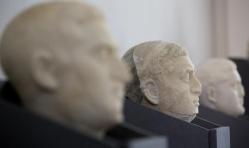 Gianola - Busts of five male heads, dating from the second or third century AD and recently excavated from the Roman Villa of Gianola, are going to display at the archaeological museum in Formia. The carefully carved hair curls around the sculpted face and deep-set eyes of one suggests the future emperor Marcus Aurelius or possibly his son Commodus, analysts say. Other faces seem equally contemporary to what has been described as one of the most ambitious Roman houses of the era to be found overlooking the Gulf of Gaeta. The busts were discovered approximately one year ago during excavations in the area of the Villa of Gianola, about 120 kilometres south of Rome. Experts say the villa may have belonged to a a dissolute knight named Mamurra, who became rich in the wars in Gaul and Spain.That allowed him to build the villa on three levels, with spa facilities so ornate that it could compete with its illustrious neighbours, says Alfonsina Russo Tagliente, Lazio regional superintendent of archaeology.
Gianola - Busts of five male heads, dating from the second or third century AD and recently excavated from the Roman Villa of Gianola, are going to display at the archaeological museum in Formia. The carefully carved hair curls around the sculpted face and deep-set eyes of one suggests the future emperor Marcus Aurelius or possibly his son Commodus, analysts say. Other faces seem equally contemporary to what has been described as one of the most ambitious Roman houses of the era to be found overlooking the Gulf of Gaeta. The busts were discovered approximately one year ago during excavations in the area of the Villa of Gianola, about 120 kilometres south of Rome. Experts say the villa may have belonged to a a dissolute knight named Mamurra, who became rich in the wars in Gaul and Spain.That allowed him to build the villa on three levels, with spa facilities so ornate that it could compete with its illustrious neighbours, says Alfonsina Russo Tagliente, Lazio regional superintendent of archaeology.
http://www.ansa.it/english/news/2015/07/15/archaeological-dig-reveals-ancient-roman-home_a977c783-8fa9-4d08-80aa-6c91dd9f1b9d.html?
INDE – Goa - Scientists in the country have found remnants of a historically important port on Goa's Zuari river which is expected to be amongst the oldest signs of human trade on the central west coast and may be contemporary to Dwarka in Gujarat. The researchers say they may discover a dockyard similar in structure to Lothal dockyard (4500 years old), discovered by Archaeological Survey of India (ASI) in Gujarat in 1954. Goa-based National Institute of Oceanography (NIO) is working on 1.2 kms long wall along the Zuari River few kms away from here and it is expected to be a part of an old port, existed anywhere between 1,000 to 3,500 AD, that is currently buried. "This area was earlier known as Gopakapattinam. The exploration work on the site is done and scientists have found the steps going in the water. It is imminent that existence of such a big wall parallel to river indicates that it is remnant of a port," said Rajiv Nigam, head of Marine Archaeology unit of CSIR-NIO. He said radio carbon and thermo-luminance [TL] dating of the sediment is required to find out correct age of this ancient port. "Also to unearth other buried structures, we want to do ground penetrating radar (GPR) survey in sandy beach area and seismic surveys in offshore area," he said.
http://www.dnaindia.com/india/report-remnants-of-one-of-india-s-oldest-ports-found-in-goa-2104862?
TURQUIE – 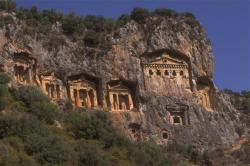 Kaunos - This year’s excavations have begun in the ancient city of Kaunos in the western province of Muğla’s Köyceğiz district. The head of the excavations, Professor Cengiz Işık, said work would continue in the city until October. He said excavations in the ancient city first began in 1966, and added, “Next year will be the 50th anniversary of Kaunos excavations. Considering Turkey’s archaeological excavations, Kaunos is one of the long-term excavation fields in the country.” Işık said the nearby Sultaniye hot springs was a sacred place dedicated to the goddess Leto in the ancient ages, and they would continue work this year in the hot springs as well as the theater area and the sacred place of Apollo. He said a five-year project had been carried out both underwater and on the ground in the Sultaniye hot springs 10 years ago, and this year they would work again in the same way.
Kaunos - This year’s excavations have begun in the ancient city of Kaunos in the western province of Muğla’s Köyceğiz district. The head of the excavations, Professor Cengiz Işık, said work would continue in the city until October. He said excavations in the ancient city first began in 1966, and added, “Next year will be the 50th anniversary of Kaunos excavations. Considering Turkey’s archaeological excavations, Kaunos is one of the long-term excavation fields in the country.” Işık said the nearby Sultaniye hot springs was a sacred place dedicated to the goddess Leto in the ancient ages, and they would continue work this year in the hot springs as well as the theater area and the sacred place of Apollo. He said a five-year project had been carried out both underwater and on the ground in the Sultaniye hot springs 10 years ago, and this year they would work again in the same way.
http://www.hurriyetdailynews.com/excavation-season-opens-at-kaunos.aspx?pageID=238&nid=85484
ROYAUME UNI – 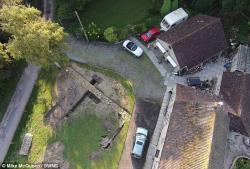 Bincknoll - Mary Hudd uncovered some strange brickwork beneath the lawn of her home in Wiltshire during the evacuation of some trees last summer. After she invited local archaeologists to investigate, they discovered the site was a treasure trove of local history, including a Saxon structure and a chapel recorded as far back as 1209. It is believed the site may have been used for religious purposes before the chapel's construction in a hamlet recorded in the Doomsday Book. The site is now believed to contain two structures, an original Saxon wall, believed to be from a religious site dating back to the 11th Century. The later chapel was then built around the Saxon structure, incorporating it into the building. The stone has slowly deteriorated or been stolen over the years, leaving just the foundations and it was last documented in the 17th century and described as 'decaying'. Descending 4ft into the ground, all the walls remain in excellent condition despite their age - but will have to covered over again or risk further decay.
Bincknoll - Mary Hudd uncovered some strange brickwork beneath the lawn of her home in Wiltshire during the evacuation of some trees last summer. After she invited local archaeologists to investigate, they discovered the site was a treasure trove of local history, including a Saxon structure and a chapel recorded as far back as 1209. It is believed the site may have been used for religious purposes before the chapel's construction in a hamlet recorded in the Doomsday Book. The site is now believed to contain two structures, an original Saxon wall, believed to be from a religious site dating back to the 11th Century. The later chapel was then built around the Saxon structure, incorporating it into the building. The stone has slowly deteriorated or been stolen over the years, leaving just the foundations and it was last documented in the 17th century and described as 'decaying'. Descending 4ft into the ground, all the walls remain in excellent condition despite their age - but will have to covered over again or risk further decay.
http://www.dailymail.co.uk/news/article-3162351/Homeowner-s-shock-13th-Century-chapel-discovered-beneath-garden.html
ROYAUME UNI – 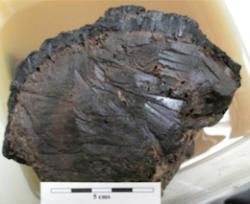 Monmouth - Archaeologists in Monmouth have discovered the remains of an ancient wooden building that dates back 5,000 years. The wooden remains found under the new Rockfield estate were once part of a crannog, an ancient fortified dwelling built into a lake, and they date back to around the year 3,000BC. The timber, which was skilfully worked with a stone axe, was unearthed during the digging of house foundations at Jordan Way by Martin Tuck of the Glamorgan-Gwent Archaeological Trust in 2003 while the group were overseeing the construction of the new Rockfield Estate. The timber was preserved beneath the clay and peat of a lagoon which formed when the lake drained some 2,000 years ago. The Stone Age timber, bearing cut marks left by stone or flint axes, formed the end of an oak post which had been carefully levelled to create a flat surface which would probably have rested on a post pad set in the bottom of the lake.
Monmouth - Archaeologists in Monmouth have discovered the remains of an ancient wooden building that dates back 5,000 years. The wooden remains found under the new Rockfield estate were once part of a crannog, an ancient fortified dwelling built into a lake, and they date back to around the year 3,000BC. The timber, which was skilfully worked with a stone axe, was unearthed during the digging of house foundations at Jordan Way by Martin Tuck of the Glamorgan-Gwent Archaeological Trust in 2003 while the group were overseeing the construction of the new Rockfield Estate. The timber was preserved beneath the clay and peat of a lagoon which formed when the lake drained some 2,000 years ago. The Stone Age timber, bearing cut marks left by stone or flint axes, formed the end of an oak post which had been carefully levelled to create a flat surface which would probably have rested on a post pad set in the bottom of the lake.
http://www.monmouth-today.co.uk/news.cfm?id=39698&headline=Ancient%20discovery%20is%205,000%20years%20old
JORDANIE – 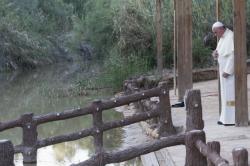 Bethany - Palestine officials are in a dispute with the UN after a Jordanian site was recognised as the historic place of Jesus's baptism by the international organisation's heritage body. During a meeting in Bonn last week, Unesco added the baptismal site of Bethany Beyond the Jordan, also known as al-Maghtas, to its World Heritage List. Unesco said that the site, which is situated on the eastern bank of the River Jordan 9km north of the Dead Sea, "is believed to be the location where Jesus of Nazareth was baptised by John the Baptist". However, the claim is contested by Palestinians, who argue that the site of Qasr al-Yahud, located just across the river in an Israeli-occupied section of the West Bank, should also be recognised as part of the site of Jesus's baptism. Due to military activity and excavations at the original site, the Israeli authorities moved the baptismal site of Qasr al-Yahud 95 km north to a site called Yardenit, just south of the Sea of Galilee, in 1981. Yardenit now claims to welcome around 500,000 tourists and pilgrims each year, despite the original Qasr al-Yahud site reopening in 2011. In the gospel of John, the site of Jesus's baptism by John the Baptist is referred to as taking place "in Bethany across the Jordan", possibly indicating biblical evidence for a Jordanian claim.
Bethany - Palestine officials are in a dispute with the UN after a Jordanian site was recognised as the historic place of Jesus's baptism by the international organisation's heritage body. During a meeting in Bonn last week, Unesco added the baptismal site of Bethany Beyond the Jordan, also known as al-Maghtas, to its World Heritage List. Unesco said that the site, which is situated on the eastern bank of the River Jordan 9km north of the Dead Sea, "is believed to be the location where Jesus of Nazareth was baptised by John the Baptist". However, the claim is contested by Palestinians, who argue that the site of Qasr al-Yahud, located just across the river in an Israeli-occupied section of the West Bank, should also be recognised as part of the site of Jesus's baptism. Due to military activity and excavations at the original site, the Israeli authorities moved the baptismal site of Qasr al-Yahud 95 km north to a site called Yardenit, just south of the Sea of Galilee, in 1981. Yardenit now claims to welcome around 500,000 tourists and pilgrims each year, despite the original Qasr al-Yahud site reopening in 2011. In the gospel of John, the site of Jesus's baptism by John the Baptist is referred to as taking place "in Bethany across the Jordan", possibly indicating biblical evidence for a Jordanian claim.
http://europe.newsweek.com/jordan-palestine-dispute-jesuss-baptism-site-after-unesco-designation-330311
FRANCE –  Comines - Notre Logis, avec Loginor, doit construire 62 logements sur le site concerné, situé entre la rue du Château et la rue d’Hurlupin. Mais les fouilles préventives, menées au début de l’année, ont notamment débouché sur la présence d’objets remontant au Xe siècle, soit l’époque carolingienne. Au vu de l’intérêt patrimonial de ces trouvailles, le préfet vient de signer un arrêté afin que des fouilles complémentaires puissent être réalisées.C’est la proximité de l’église Saint-Chrysole qui avait déclenché ces fouilles préventives. Le rapport des experts avait aussi notifié la présence de céramiques des X et XIIe siècles « particulièrement intéressantes. » « Il y a un véritable intérêt archéologique » à ce site, nous avait expliqué, début juin, Virginie Motte, de la Direction régionale des affaires culturelles. Elle avait alors rendu un avis préconisant des fouilles complémentaires.
Comines - Notre Logis, avec Loginor, doit construire 62 logements sur le site concerné, situé entre la rue du Château et la rue d’Hurlupin. Mais les fouilles préventives, menées au début de l’année, ont notamment débouché sur la présence d’objets remontant au Xe siècle, soit l’époque carolingienne. Au vu de l’intérêt patrimonial de ces trouvailles, le préfet vient de signer un arrêté afin que des fouilles complémentaires puissent être réalisées.C’est la proximité de l’église Saint-Chrysole qui avait déclenché ces fouilles préventives. Le rapport des experts avait aussi notifié la présence de céramiques des X et XIIe siècles « particulièrement intéressantes. » « Il y a un véritable intérêt archéologique » à ce site, nous avait expliqué, début juin, Virginie Motte, de la Direction régionale des affaires culturelles. Elle avait alors rendu un avis préconisant des fouilles complémentaires.
http://www.nordeclair.fr/info-locale/comines-des-fouilles-complementaires-sur-le-site-hurlupin-ia47b1807n785690
ALLEMAGNE - Lueneburg - n amateur archaeologist in Germany has found a historic collection of gold coins worth around 45,000 euros, probably buried during the Nazi era or shortly after World War Two, experts said on Wednesday. Armed with a metal detector, Florian Bautsch found 10 coins in a hollow under a tree near the northern town of Lueneburg and professionals then excavated another 207. They are of French, Belgian, Italian and Austro-Hungarian origin and date from 1831 to 1910. Two aluminum seals featuring swastika crosses, eagles and the words “Reichsbank Berlin 244” were also discovered under the field with the coins. Germany’s central bank was called “Deutsche Reichsbank” during the Nazi era and an analysis of the metal in the seals suggests they were made some time after 1940.
http://forward.com/news/breaking-news/312058/german-amateur-archeologist-finds-50k-trove-of-gold-coins-from-nazi-era/#ixzz3fywfrRjI
TURQUIE – 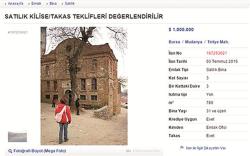 Mudanya - The 700-year-old arched church in the northwestern province of Bursa’s Mudanya district has been put on sale on the Internet for $1 million, news website T24 has reported. The 13th century church is filed under the top category “building more than 31 years old.” A document written by a Dr. J. Covel in 1676 states that the church was dedicated to Panagia Pantobasillissa (The Queen of All - Virgin Mary). The church’s dome and bell tower collapsed during an earthquake in 1855 and was restored in 1883.
Mudanya - The 700-year-old arched church in the northwestern province of Bursa’s Mudanya district has been put on sale on the Internet for $1 million, news website T24 has reported. The 13th century church is filed under the top category “building more than 31 years old.” A document written by a Dr. J. Covel in 1676 states that the church was dedicated to Panagia Pantobasillissa (The Queen of All - Virgin Mary). The church’s dome and bell tower collapsed during an earthquake in 1855 and was restored in 1883.
After Greeks who had lived in the area for centuries emigrated to Trilye in the 20th century in the population exchange between Greece and Turkey, the church passed to private ownership.
http://www.hurriyetdailynews.com/historic-church-in-turkeys-bursa-for-sale-on-internet.aspx?pageID=238&nid=85217&NewsCatID=375